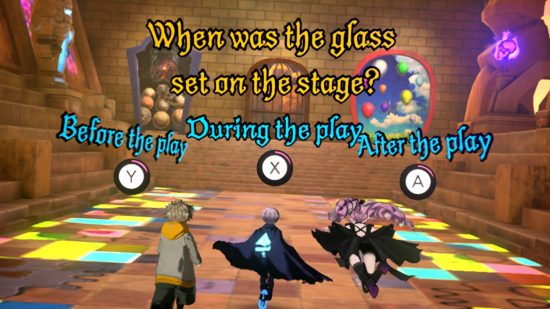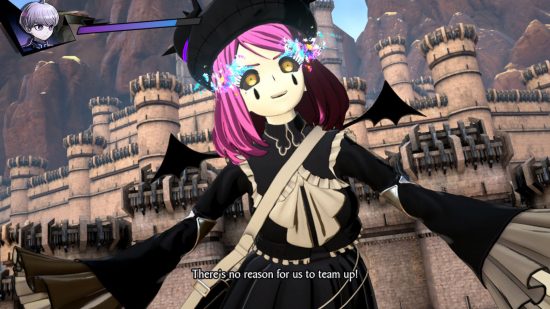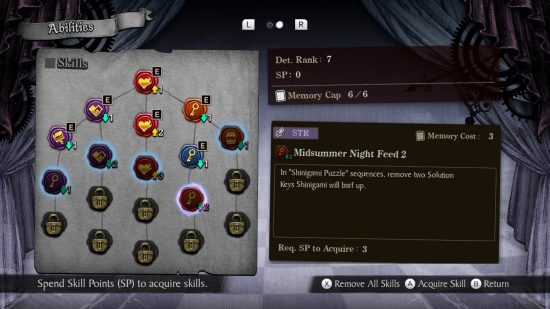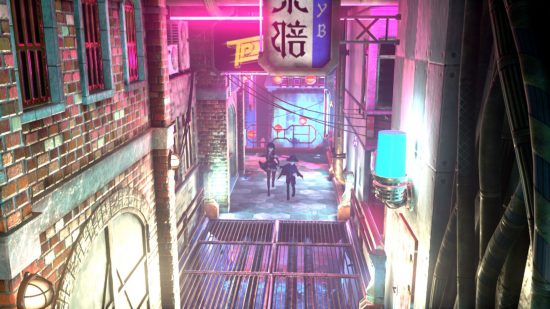Master Detective Archives: Rain Code is one of my most anticipated games of the year. I mean, Danganronpa meets Persona 5 with a dash of AI: The Somnium Files? How could I say no? Well, this game really didn’t live up to my expectations. It completely boom-killed ‘em and blew me away in the process. And, in this here Master Detective Archives: Rain Code review, I’m gonna do my best to tell you exactly why, while avoiding spoilers as much as possible – because, honestly? I’d much rather leave those mysteries for you to uncover, Master.
I’ll start by setting the scene. You take the role of an amnesiac (look, I know, I know, if I had a dollar for every time I wrote that, I’d be living in a Kanai Tower penthouse by now, but hear me out, it really does work here) detective-in-training called Yuma Kokohead who works for the legendary World Detective Organization (WDO).
As it turns out, Yuma Kokohead has an empty coconut head because he made a contract with a death god called Shinigami. In exchange for his memories, Shinigami is a permanent feature in his life, helping him in his quest to solve mysteries and become a top-notch master detective.

You join Yuma and Shinigami on their way to Kanai Ward, a neon-lit cityscape under a perpetual rain cloud, fraught with unsolved mysteries and oppressed by the corrupt Amaterasu Peace Corporation. There, you team up with a group of fully fledged master detectives, each with their own forensic fortes – unique special powers like clairvoyance or mind-reading – as you take on multiple cases and challenge the Peacekeepers in pursuit of uncovering ‘Kanai Ward’s Ultimate Secret’.
The gameplay is predominantly split into two parts. The first is where you explore the stunning but soggy Kanai Ward, seeking out cases, talking to witnesses, investigating crime scenes, and gathering clues. Kanai Ward is segregated into multiple districts which open up to you as you progress through the story, each filled with unique secrets to uncover and people to meet.
The separate districts are independently instanced, and you can travel between them on foot or by bus. The Kanai Ward buses are essentially a fast travel system, allowing you to teleport to a location from your map, or approach a bus stop and choose where you want to go. While the map itself isn’t particularly big, many of the districts are made up of multiple winding paths and levels, so the option to fast travel is much appreciated, and I love the use of a bus service and bus stops to implement this.
In addition to the main story missions, you can also pick up side-quests around Kanai Ward. A lot of them are pretty basic, such as talking to a couple of NPCs to gather intel or offer assistance, but they add a lot to the game’s worldbuilding and your understanding of the citizens you have to protect. There are also some genuinely intriguing little stories to unravel and, with how easy they are to complete, I highly recommend picking them up as soon as they appear on your map and completing them passively as you go.
The second half of the gameplay takes place in the Mystery Labyrinths. Similar to palaces in the Persona games, Mystery Labyrinths are manifestations of real-world mysteries, and the truth behind the case is hidden deep inside. The only way to progress through a labyrinth is to solve the mystery that manifests it. If you don’t manage to crack the case, the Mystery Labyrinth continues to expand and distort until it seeps into the real world.
Shinigami can open a pathway into a Mystery Labyrinth, allowing Yuma to enter and unveil its secrets. Inside, you must overcome many obstacles using the ‘solution keys’ (essentially clues) that you and Shinigami discover while investigating the case in the real world. The labyrinths offer a pretty hefty array of different gameplay mechanics, and each one has a unique layout and vibe inspired by the mystery at hand.
The labyrinths rely on you using your own detective skills in order to progress and uncover more secrets. Whether it’s choosing the door that’s marked with the right answer to a question, reconstructing a crime scene, or tracing a perpetrator’s steps, the gameplay elements are always switching around to keep things feeling fresh. Oh, and there’s also the Shinigami Puzzle sections, where you throw knives at a spinning barrel with a bikini-clad Shinigami inside to spell out a missing word. It’s utterly bizarre and fanservice-y but I love it.
Yuma also has a stamina meter that acts as HP, and you lose a chunk of stamina whenever you make a wrong move. This adds a sense of peril to the labyrinths, while also amplifying your sense of accomplishment when you manage to crack a clue on your first attempt. But don’t worry, if you’re ever struggling to remember some key information, the pause menu has a glossary full of handy terms and gameplay tutorials, profiles for all characters of interest, a full list of all your solution keys, and more.
Of course, progressing through the labyrinths isn’t as simple as choosing the right doorway or browsing through your solution keys until you work out who’s the culprit – there are also a bunch of pesky Mystery Phantoms for you to go up against, and their main goal is to mislead you and put you off solving the case.
Now, fighting these phantoms is nothing like your average combat – it’s not an action-style pow-wow where you hit baddies with your key like in the Kingdom Hearts games, nor is it a turn-based affair where you use skills and attacks to take ‘em out like in Persona. Nope, you must instead fight with logic and knowledge, using the magical Solution Blade that you pull out of Shinigami’s throat when you enter the labyrinth… Uh, yeah. I guess it isn’t any weirder than those giant keys, right?
Combat comes in the form of Reasoning Deathmatches, where you face off against the Mystery Phantoms as they hurl accusations, misleading statements, and outright lies at you. There are two types of Reasoning Deathmatches – one in which you must rebuttal flawed statements, and the other where you need to slash through false claims with the correct solution.
During the latter, you have a selection of solution keys to choose from. Pick the right one and equip it to your blade, then slash through the right statement to hurt the Mystery Phantom. If you slash the wrong statement or use the wrong solution key, you lose stamina, have a lil pep talk with the love of my life Shinigami, then start again.
In addition to picking the right solution keys with the Y button and slashing or rebutting the right statements with the X button, you also have to dodge all the other statements the Mystery Phantoms throw at you by hopping left and right, ducking, or jumping with the joystick. Of course, getting hit also damages you and lowers your overall performance score at the end of the labyrinth.
To top it all off, there’s also the noise that the phantoms throw out to distract you. Noise appears in a pink font, and you can cut through it by slashing with the A button – though I find it often takes a few hits of the A button to actually get rid of them, as Yuma’s slashes can be hard to place, especially when you’re dodging everything else.
I really like the unique direction Master Detective Archives: Rain Code takes combat. It draws some similarities with the class trial debates in the Danganronpa games, but is a bit more polished and advanced. The Reasoning Deathmatches are generally pretty short but I do find them enjoyable, and stopping to flick through your solution keys to pick the right one for battle allows some breathing room.
However, it certainly takes some getting used to, and I initially felt like there was too much going on with so many moving parts and different things to focus on. I’ve grown more accustomed to the mechanics over my playtime, though I occasionally still find myself hitting the wrong button when things get particularly busy or misjudging the distance between Yuma and a statement I need to dodge. Then again, I did choose a tougher difficulty when starting my save file, so it may be a bit more forgiving on lower difficulty settings.
As you explore Kanai Ward, you earn DP (detective points) by interacting with objects, completing quests, talking to NPCs, etc. DP essentially acts as EXP in this game, and when you gather enough to increase your Detective Rank, you can unlock and equip abilities on a skill tree.
These abilities branch into a total of five paths, offering handy bonuses to help you in the Mystery Labyrinths such as increased stamina and movement speed, less solution keys to choose from in Reasoning Deathmatches, and more. The skill tree is pretty basic compared to the sprawling options offered in hefty RPGs, but it adds a nice sense of progression and encourages you to really tune into your inner detective as you examine every little thing you come across.
Now, let’s talk about the characters. Master Detective Archives: Rain Codes’ characters are absolutely great – though, to be honest, after meeting all of the Danganronpa characters, I wouldn’t expect anything less. From the other master detectives to the intimidating Peacekeepers, the designs are absolutely brilliant, and every time a new one crops up I can’t wait to learn more about them.
Yuma himself is an adorable little guy, and, as much as he’s soft and seriously lacking in self confidence, his strong sense of justice and selflessness makes him a pretty loveable protagonist to ride alongside. Plus, he’s the perfect counterpart to the zany death god he’s tethered to.
On the topic of Shinigami, I’ve personally fallen head over heels for her. I’m not sure whether I want to be her or marry her, but either way, she’s an absolute gem. Her cheerful, chatty disposition paired with her off-color sense of humor and questionable morality makes her an absolute delight to have around. She’s a possessive, tone-deaf, bloodthirsty little monster, and I can’t get enough of her.
Shinigami also does a lot to brighten up the dark streets of Kanai Ward, though she’s not the only one. Between the silly puns, tongue-in-cheek jibes, subtle jabs at pop culture, and sprinkling of innuendos, the game is filled with a deliciously dark sense of humor that does a great job of balancing the dark themes it handles. You may be investigating corpses, unfurling murder-suicide cases, and uncovering deep governmental corruption and societal injustices, but with the sometimes-lewd, ever-chaotic death god Shinigami by your side, it’s hard not to crack a smile every now and then.
And, to sweeten the deal even further, the voice acting in this game is brilliant. The VAs suit their characters perfectly, injecting a real sense of life and energy into everyone you meet. I was initially surprised to see that the voice of Genshin Impact’s Dori, Anjali Kunapaneni, would be taking the reins as Shinigami, but I soon realized that no one could have suited the role better. The same can be said for any of the central characters, too – from Lucien Dodge perfectly conveying the soft-spoken Yuma to Aleks Le portraying the eternally lethargic Vivia, I love them all.
The rest of the sound design is brilliant too. The sound effects are well-placed and add a real sense of weight to your actions, and the OST is absolutely fab, with many jazzy tunes that feel reminiscent of the brilliant music in Persona 5. Whether you’re listening to a whimsical tune as you inspect evidence or some heavy chords as you discover a body, the vibes are spot on and truly amplify the mood in each scene.
Beyond the characters, the aesthetic of Master Detective Archives: Rain Code continues to shine. Each area of Kanai Ward is beautifully designed, maintaining its own unique identity and atmosphere while still clearly fitting in with the rest of the map. The dark, moody streets weighed down with the constant rainfall perfectly reflect the oppressive situation the people of Kanai Ward live in, and the vivid neon lights and melding of futuristic technology and old architecture make for a truly rich world.
The Mystery Labyrinths also never fail to impress, with their garish exteriors, long, twisting corridors that twist and transform before your eyes, and dream-like portals leading further inside. Then there’s the Mystery Phantoms, each of which represents a distorted version of a character from the real world. They’re huge and intimidating, with striking outfits that seem to combine cyberpunk and glam-rock aesthetics, and each time I confront a new one, I can’t help but eyeball them in awe.
In terms of performance, the Switch handles this game pretty well. Load screens are pretty snappy on my Switch OLED, the environments look great in both handheld and docked mode, I’ve experienced no stuttering or framerate drops, and the visuals have minimal artifacting, popping, or clipping. The stylized graphics and separately instanced districts seem to reduce the strain on the Switch’s aging hardware, and as a result things look pretty great – obviously not to the same standard as other current-gen console and PC games, but enough for me to stop and say ‘wow, this looks pretty’ and take a screenshot at regular intervals.
The only issue I’ve had with performance is, during a few sequences in the early game, the resolution seemed to go a bit squiffy, leaving the character models strangely blurry. Restarting the game didn’t do anything to help, so I can’t help but feel it’s an issue with the Switch rendering the scenes. However, it didn’t really impact my enjoyment of the game, and it cleared up on its own after a while.
Okay, I’ve gone on for long enough now, I think you get the idea. After pumping in over 30 hours, I can safely say that Master Detective Archives: Rain Code is a master(detective)piece. I genuinely adore this game, and it’s currently competing with Resident Evil 4 Remake as my GotY.
Its striking design, immersive world, quirky characters, and clever cases add up to make something truly special, and, while it may draw parallels with some great games that come before it, its ambitious and unique gameplay and story make it stand out on its own as not just a great detective game, but one of the best Switch games I’ve played. It’s an unforgettable, mysteriful cult classic in the making, and I can’t wait to see what other mysteries are on the horizon.
Master Detective Archives: Rain Code review
Master Detective Archives: Rain Code is a mysteriful masterpiece boasting an immersive world, quirky characters, unique gameplay, and a heap of captivating cases to crack. Engaging from start to finish, it’s clear that your adventure with Shinigami and Yuma is a cult classic in the making.


















